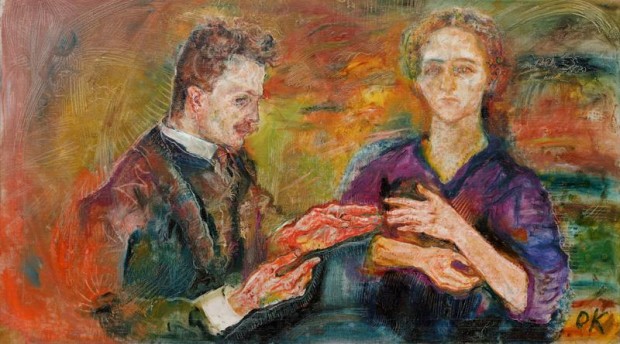You have no items in your cart. Want to get some nice things?
Go shopping
Bourgeois self-congratulation—so en vogue in government and the City these days—rarely produces inventive or crowd-pleasing art, and especially not when it come with greased facial hair and a century’s coat of fustiness. Generations of English middle class portraits are safely lost in family attics, and some of the gilt-framed vainglory on display in the National Gallery’s new exhibition of Viennese portraiture should have been forgotten too. The most stuffily historical of them—Hans Makart’s sycophantic likenesses of richly-upholstered society women and Gyula Benczúr’s love-struck portrait of a young, smug Empress Sisi, decades after her middle age and a year after her assassination (and never as dewy as Romy Schneider)—are not so much “Facing the Modern” as staring stubbornly backward and plugging their ears to it.
The Portrait in Vienna 1900 is playing on our own pining for an amber-bound time of Art Nouveau, fresh neuroses, love affairs worth dying for; the Vienna of Freud and Klimt and Mahler—or, more appropriately, of Carl Schorske. But first we have to attend to the Viennese’s own historical manias: the first room—fully a sixth of the exhibit—is turned over to that time warp. The gimmick is the rehanging of a 1905 exhibit at the Miethke Gallery, which carted stultified Biedermeier grandeur into the unstable new century and supposedly inspired Vienna’s new burghers to solidify their own images in portraiture. It reads like a sarcophagus of great lost Franzes: Friedrich von Amerling’s study for a portrait of Emperor Franz I, dead seventy years; a death mask of Beethoven, dead eighty; Franz Eybl’s portrait of the artist Franz Wipplinger, dead, looking longingly at a miniature of his sister, pre-deceased.
For a middle class that snatched up artists’ death masks to assert a cultural genealogy—Schiele, Mahler, Loos and Klimt’s are on display here later, Gustav’s skewed with the stroke that killed him—and itself often had a thin list of forbearers, this morbidity is essential. The Miethke gallery facsimile is supposed to be the imaginary ancestral hall of the new century’s elite, which was wholly more entrepreneurial, landless and Jewish than their apocryphal ancestors would have tolerated. They were no longer scrambling for Sachertorte crumbs from the imperial table—the Viennese culture we adulate has been characterized as a primarily bourgeois and/or Jewish invention—but the Habsburg Empire was viciously image-conscious and class-bound. Even in the heady fin-de-siècle, Vienna was still Robert Musil’s sclerotic and stratified Kakania, hobbling with Hungary in a three-legged race to war and dismemberment. Mostly, its bourgeoisie was bent to a lily-livered self-affirmation in portraits, whether they were posing in 1848 or 1914.
Most reviews of the exhibit have complained about its disorganized chronology and the National Gallery’s incoherent attempt to package portraits into précises on self-creation, family life, and “love and loss”. Maybe a thematic ordering was a mean-spirited trick to play on a public lured in with the tidy historiography of “Vienna, 1900” and a linear idea of how a city spiralled from Habsburg to hedonism. The ubiquity of Hans Makart and his finely-baubled society ladies is unsurprising, although he died sixteen years before the marquee date. His historicism, plied with a sensuality and detail to decoration that would inspire Klimt, was all the rage in Viennese high society for a generation. Klimt’s earliest pieces on show—a staid Seated Young Girl and Lady in Black, a hidebound Madame X —show all the influence of Makart’s genteel lushness and little of the bedazzled sinuousness of Klimt’s own famous work. But these decorous portraits were the best way to claim prestige and those who dared to sit for Schiele, Richard Gerstl or Oskar Kokoschka were often horrified by the Secessionist’s stylised distortions of their faces and reputations
Kokoschka’s Portrait of Lotte Franzos, depicting a socially prominent wife with nervous hands and a pincer mouth, drew jeers from critics, who interpreted the blue shadows Kokoschka used to hem his ghosted subject as “a foul smell”. When Frau Franzos complained to Kokoschka for parading her through the press as rancid, he threatened to burn the painting. Critics Hans Tietze and Erica Tietze-Conrat simply hid their portrait by Kokoschka—a near-hysterical figment of martial discord in a gloaming of paint—from public view for decades. When Richard Gerstl painted Karoline and Pauline Fey in their fine ball gowns, he transformed the young sisters into a pair of Miss Havishams, spectral and old beyond their years—no Makart red and sumptuousness here.
The exhibit’s success is less a tribute to the nerve of the Viennese burghers than to the brilliance of the artists working for—and against—them; or, more aptly, to the cult of fin-de-siècle Vienna and the National Gallery’s canny marketing of it. The portraits that are truly remarkable here—Schiele’s gnarled self-portraits; Gerstl’s stark, suicidal navel-gazing and Kokoschka’s jittery shop prophets—owe little to that traditional middle class patronage. They’re the avant-garde posturing of an upwardly mobile Jewish class that had less to lose in a portrait’s gamble, or the self-flagellating and reifying mirrors of the artists themselves. They’re likenesses of friends and family and anyone who could be bribed to sit and strip—often faceless working-class girls—subjects who didn’t have the grounds to protest like the Ringstrasße set did.
When Broncia Koller—one of the few female artists included in the exhibit—painted the working class Marietta nude, she shattered convention by giving her a name in the title, depicting her body without a leering or an odalisque pose, and framing her face in a Secessionist golden square. Nude Portrait of Marietta is a nude doubled as a portrait and, with the Klimts here unsparkling or unfinished, it boasts one of the few blocks of gold here outside of the ostentatious frames. Schiele rarely gave his beloved red-haired Wally the dignity of a name.
You won’t find any of Schiele’s erotica here—his famous women with carefully tumbled petticoats and exposed genitals are curiously absent—but you will find his wicked deconstruction of middle class respectability: a grim family portrait of nudes, his own sinewy, rack-stretched arms and legs framing a family that isn’t his—a hired girl, maybe a prostitute, and a baby that would never exist. His own wife would die of Spanish influenza that same year, six months pregnant. Schiele would paint her on her deathbed, calm in a febrile eddy of hair, as Von Amerling had painted his own dying wife seventy five years earlier.
The Viennese in this exhibit are not so much hounded by death as transfixed by it. We see this Vienna with the narcotic fatalism of hindsight, and the contemporaries probably shared that millennial doom. Klimt painted the 24-year-old Ria Munk in life only after her parents commissioned, and were displeased with, a portrait of her in death. The paintings straddle adjacent wall here: Ria, bright-cheeked, as if asleep in a wreath of funeral flowers, and then standing but ghosted down to sketching, swallowed by Klimt’s verdant Jugendstil eyes and swirls. Klimt himself died before he could fill out her dress.
Facing the Modern: The Portrait in Vienna 1900 closes on January 12 2014. See the National Gallery website for more information.





